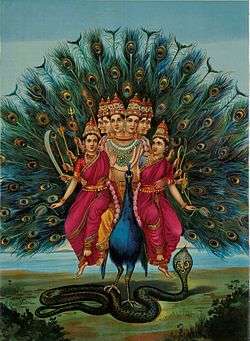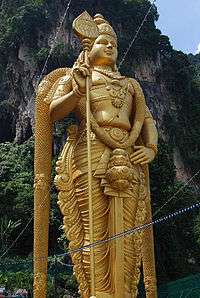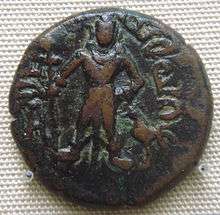Vel
Vel (Tamil: வேல், lit. 'Vēl') is a divine javelin (spear) associated with Murugan, a Hindu war god also known as Vel Murugan. Spears used by ancient Tamils in warfare were also commonly referred to by this name. "Vetrivel! Veeravel!" ("Victorious Vel, Courageous Vel") was a commonly used battle cry by ancient Tamil kings and soldiers.[1]
| Part of the series on |
| Kaumaram |
|---|
 |
|
Six sacred abodes
|
|
| Vel | |
|---|---|
 Murugan statue with Vel at Batu Caves, Malaysia | |
| Type | Spear |
| Place of origin | India |
Hindu mythology
According to Hindu mythology, Goddess Parvati presented the Vel to her son Murugan as an embodiment of her shakti or power in order to vanquish the evil asura Soorapadman. According to the Skanda Purana, in the war between Murugan and Soorapadman, Murugan used the Vel to defeat all the evil forces of Soorapadman. When a complete defeat for Soorapadman was imminent, the asura transformed himself into a huge mango tree to evade detection by Murugan. But not fooled by Asura's trick, Murugan hurled his Vel and split the mango tree into two halves, one becoming Seval (a rooster) and the other Mayil (மயில்-தமிழ்) Tamil (a peacock). Henceforth, the peacock became his vahana or mount and vehicle and the rooster became the emblem on his battle flag.
Vel, as a symbol of divinity, is an object of worship in the temples dedicated to Murugan. The annual Thaipusam festival celebrates the occasion when Murugan received the divine Vel from his mother. During this festival, some of the devotees pierce their skin, tongue or cheeks with vel skewers while they undertake a procession towards the Murugan temple.
Adi-Vel is a major festival observed in Sri Lanka by Tamil Hindus in the month of July/August, known as Adi.[2] The festival take place cities such as Kathirakamam and Colombo.[3]
The alternative interpretation of Vel is that it is a symbol of wisdom/knowledge. It symbolically shows that wisdom/knowledge should be sharp as in the Vel's tip, broad as in the vel's breadth and run deep as in the height. Only such wisdom can destroy the darkness of ignorance.[4]
Gallery
 Stone vel from the Sangam period, Saluvankuppam, Tamil Nadu
Stone vel from the Sangam period, Saluvankuppam, Tamil Nadu Vel, used to worship in temple
Vel, used to worship in temple Statue of Murugan with Vel
Statue of Murugan with Vel Coin of the Yaudheyas 200 BCE, depicting Murugan with the Vel.
Coin of the Yaudheyas 200 BCE, depicting Murugan with the Vel.
See also
References
- Kumar, Madhan (2017-07-11). Thamizh Is Not Just A Language: The Valour. Educreation Publishing.
- Elliott, C. Brooke (1995). The Real Ceylon. Asian Educational Services. ISBN 9788120611351.
- Tambiah, Stanley Jeyaraja (1986). Sri Lanka: Ethnic Fratricide and the Dismantling of Democracy. I.B.Tauris. ISBN 9781850430261.
- Natarajan, Muni (2012-07-02). A Monk's Tale. ISBN 9780985701918.